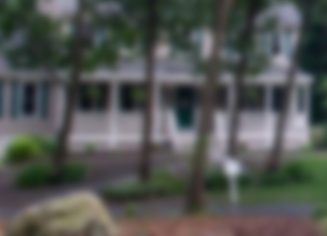Continuing on the instructions of my last post, How to look at stuff.
When you look for the smallest detail in anything you’re looking at, you should only be looking at a detail you can already see. The important thing is to keep reminding yourself to consider what the smallest detail you can perceive is in what you’re looking at. It’s fine if it’s blurry. Even within a mess of blur, the smallest detail you can perceive is smaller than you may think, and you don’t know until you consider looking for it.
Let’s look again at the same photo we looked at before.
 This time I made it blurry. No matter how blurry it is, the same principles apply.Look at the large rock on the bottom left. The fact that we can’t see sharp details on the rock makes no difference. We still look at it by the same method. Look at one of the large dark spots on the rock. The spots aren’t entirely black. They contain varying shades of color, and each spot of a different shade is another detail. The dark spot on the right actually contains an area of lighter color. And that lighter color contains shades too, as it fades towards the darker color. So there are a lot of different colors there. If you were to divide the dark spot into individual pixels, each pixel being one color only, how many pixels would there be?
This time I made it blurry. No matter how blurry it is, the same principles apply.Look at the large rock on the bottom left. The fact that we can’t see sharp details on the rock makes no difference. We still look at it by the same method. Look at one of the large dark spots on the rock. The spots aren’t entirely black. They contain varying shades of color, and each spot of a different shade is another detail. The dark spot on the right actually contains an area of lighter color. And that lighter color contains shades too, as it fades towards the darker color. So there are a lot of different colors there. If you were to divide the dark spot into individual pixels, each pixel being one color only, how many pixels would there be?
So you have determined the size of the smallest detail of a single color you can perceive. But when you look at such a small piece, you have a hard time seeing it. It starts to disappear as soon as you try to look directly at it. That is something that people with normal vision deal with too. The difference is you struggle against such a result by trying to lock your eyes into place and keep that one detail. The fact is that you can only see such a detail for an instant before it begins fading. The right way to deal with this problem is to look at another nearby detail of the same size, or perhaps smaller. And so you continue looking at details that elude you almost as soon as you look at them.
Every time you shift your attention to a nearby spot, look closely for a couple seconds so that you can satisfy yourself that you know how small a single piece of color is that you can perceive in that spot. Doing so is just a matter of noticing. Just making a mental note of it. What you’ll notice is that in looking for a small detail is you’re actually shifting your gaze slightly as you sift through the blur. So really there is no rule about any number of seconds you should spend on each spot to keep from locking your gaze, because when you do this as described, you don’t have an opportunity to lock your gaze. Spending a couple seconds on each spot is just a suggestion to give yourself a bit of time to deliberately and consciously note what you can see every time.
This is going to be slow and deliberate at first. Your visual system likes to have a single tiny piece of color as the “main” point while it processes the entire visual field. As you get used to it, you will become able to more quickly find the smallest point you can see and thereby more quickly move to the next spot. This is what people with normal vision do. When they look at something, they are able to quickly look for the smallest detail before moving on.
Don’t try to figure out where your center of vision is or try to place a small invisible point at what you look at as if to “frame” a small point. People make this mistake when trying to practice “central fixation”, a concept of the Bates method that is often misunderstood. Don’t make this about moving your eyes around either, as if that it’s somehow good just to keep your eyes moving. Your actions in looking at details have to be solely about the actual details you can perceive.
get help on our Facebook Group!

I founded iblindness.org in 2002 as I began reading books on the Bates Method and became interested in vision improvement. I believe that everyone who is motivated can identify the roots of their vision problems and apply behavioral changes to solve them.
